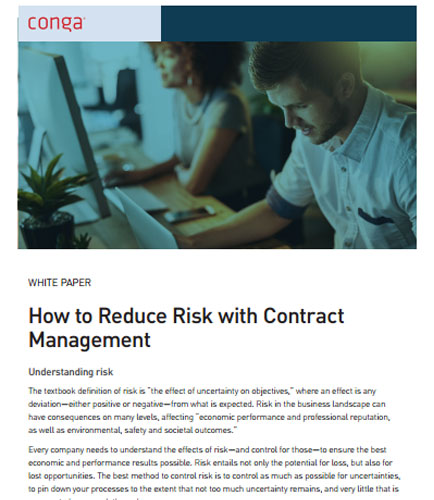
PROCESSING. PLEASE WAIT...

White Paper: Conga Novatus
In this fast-moving and highly competitive global marketplace, proper commercial contractual risk management is necessary for success. Ongoing successful company revenues, profits, and reputations can be wiped out quickly by ignoring or not discovering contractual risk threats.
Conversely, if an entity is protected from contractual risks and threats, it can effectively concentrate and focus on its business without distraction.
This Conract Management whitepaper describes where the weak points in the contract lifecycle appear, and where risk is most likely to be introduced into the process to establish bulletproof contract management procedures.
Key takeaways from this Contract Management White Paper:
Automatic renewal of contracts
An inability to access contract terms
Important features for any contract management plan
Minimizing Contractual risk with an effective CLM tool

Today, efficiency is a necessity for implementing and main¬taining a foolproof Enterprise Contract Management (ECM) system–and doing so can re¬sult in substantial revenues and cost savings, while minimiz¬ing business risk. Businesses are looking to leverage smarter technologies in their contract management system to make it possible for teams to handle ever-expanding demands. With execu-tive teams typically hesitant to commit additional resources to contract management functions, CIOs need a cost-effective system that can allow lean teams to design the patterns of contract behaviors for repeated use without getting hands-on and knee -deep in every contract.
By: HighRoads
Each year, HighRoads surveys companies about their current processes and future plans for compliance communications. In 2013, HighRoads invited mid- to large-sized organizations throughout the United States to share information about their compliance and governance operations; their approach to producing, updating and distributing Summary Plan Descriptions (SPD) and the steps they are taking to generate the Summary of Benefits and Coverage (SBC) and other required notices under the Affordable Care Act (ACA). Benefits communication straddles an unusual line between the everchanging requirements of government regulation, the increasing need for clear, concise and understandable content and changing preferences for how to receive and send information. That said, there are some things that remain constant from year to year-such as what employers find most challenging and the lack of good data around compliance expenditures.
By: Signavio
An enterprise-wide process modeling is the most agile way to conduct a successful digital transformation as it requires a top-down examination of the performance, quality and sustainability. Digital transformation is an essential step in the evolution of many businesses today. Process modeling has grown from creating a diagram or report figure that explains a business problem to a transformational practice that can organize the way a business is monitored, controlled, and measured. This whitepaper discusses why businesses should consider an enterprise-wide process modeling approach for competing through digital transformation. Key takeaways of this white paper: Take Process Models out of isolation within your business Nurturing digital business transformation by focusing on your process From business process mapping to enterprise business process modeling Ways to instigate enterprise-wide process modeling


 2025 All Rights Reserved | by: www.ciowhitepapersreview.com
2025 All Rights Reserved | by: www.ciowhitepapersreview.com